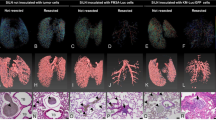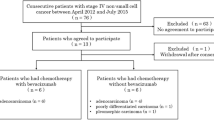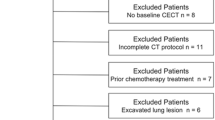Abstract
The effect of melphalan on the growth of 4 different lines of human lung-tumour xenografts has been established. The oat-cell carcinoma was the most sensitive, whereas the adenocarcinoma was the most resistant. Two lines of large-cell anaplastic carcinomas were intermediate in sensitivity. The differences in sensitivity were not reflected in the gross uptake of drug into the tumours. There was, with the exception of the adenocarcinoma line, a marked decrease in uptake per g tumour with increasing tumour size. This was partly caused by a decrease in the vascular supply in the same tumours with increasing tumour size. Extravasation of plasma proteins increased with increasing tumour size in all tumours, but was much less pronounced in the adenocarcinoma than in the other tumour lines. The extracellular volume of the various tumour lines did not vary with tumour size.
This is a preview of subscription content, access via your institution
Access options
Subscribe to this journal
Receive 24 print issues and online access
$259.00 per year
only $10.79 per issue
Buy this article
- Purchase on Springer Link
- Instant access to full article PDF
Prices may be subject to local taxes which are calculated during checkout
Similar content being viewed by others
Rights and permissions
About this article
Cite this article
Wist, E., Millar, J. & Shorthouse, A. Melphalan uptake in relation to vascular and extracellular space of human lung-tumour xenografts. Br J Cancer 43, 458–463 (1981). https://doi.org/10.1038/bjc.1981.67
Issue Date:
DOI: https://doi.org/10.1038/bjc.1981.67
This article is cited by
-
Human tumor xenografts as model for drug testing
CANCER AND METASTASIS REVIEW (1988)
-
Predictive tests in cancer chemotherapy a reappraisal
Klinische Wochenschrift (1984)



